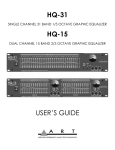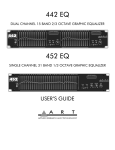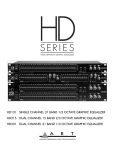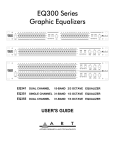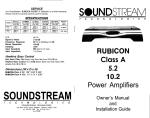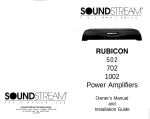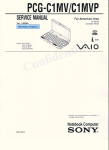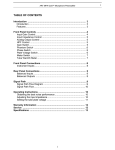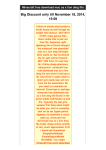Download Art HQ231EQ User`s guide
Transcript
HQ-231 DUAL CHANNEL 31 BAND 1/3 OCTAVE GRAPHIC EQUALIZER with FDC™ - Feedback Detection Circuit USER’S GUIDE GENERAL INFORMATION HQ-231 DUAL CHANNEL 31 BAND 1/3 OCTAVE GRAPHIC EQUALIZER WITH FDC™ Congratulations on the purchase of your new ART equalizer. This professional equalizer is perfect for all applications and is also well suited for signal processing in situations where feedback is possible. It’s features include ART FDC™ (Feedback Detection Circuit), and constant Q circuitry with a 3% center frequency accuracy. It also features LED level metering, selectable range 6dB or 12dB, active balanced and unbalanced input/output connectors, RFI filters, independent variable Hi Pass (low cut) and Low Pass (high cut) filters, variable input level control, passive bypass switch, clip level indicator, ground lift switch, and selectable line voltage switch. The unit also features automatic bypass if power to the unit is lost. FDC™ - ART’s FEEDBACK DETECTION CIRCUIT FDC (Feedback Detection Circuitry – designed and developed by ART Engineering) instantly illuminates the corresponding EQ band with the greatest signal. That is, if feedback occurs, FDC identifies the band with the feedback frequency for quick correction. During operation, various LED’s will illuminate as the signal passes. The loudest band will correspond with the brightest LED. When you hear feedback, FDC (and it’s brightest LED) shows you where to attenuate. FDC confirms what you hear (feedback), and shows you exactly where it is. You’ll also know you have properly attenuated the signal as the LED reduces its illumination. FDC - it is both precise and simple. FDC APPLICATIONS FDC allows you to observe those frequency bands with the greatest energy when program material is being played. In a live sound system where the HQ EQ is in the path between a microphone and loudspeakers, dominant room modes may be seen as bands with a lot of energy when the sound system gain is increased. These bands with excess energy will brightly illuminate the corresponding led in the offending frequency’s fader. These frequencies will generally be the first where feedback is likely to occur. 2 FDC can also be employed as a simple spectrum analyzer along with its primary use with the equalizer. This will allow you to identify “hot” spots – area of potential feedback – and attenuate accordingly before feedback occurs. Of course, during a musical performance, FDC will help you quickly locate and eliminate feedback if it occurs. Be careful when running a sound system close to its feedback limit. Feedback can damage equipment as well as hearing. FDC SYSTEM PRECISION The HQ EQ circuitry is extremely precise. The equalizer features Constant-Q Filtering, which helps the HQ’s FDC work with great efficiency. When feedback occurs at a certain band, the ensuing attenuation will not affect surrounding bands. This precision is, of course, critical for professional applications. INSTALLATION These equalizers are designed for mounting in a standard 19” equipment rack or one of the many rack type portable cases available on the market. The vertical height is 3.5 inches and depth is 7.5 inches. POWER CONNECTORS This series of graphic equalizers have internal power supplies and are designed for operation from 120 or 240 volt, 50-60Hz mains supply. Power consumption is 30 watts. In new installations and portable sound systems, or any situation in which the mains power is in question, it is wise to confirm the voltage and select the appropriate line voltage switch BEFORE connecting the equalizer to power sources. INPUT/OUTPUT CONNECTIONS This series of graphic equalizers have 3 sets input output connectors wired in parallel: XLR, 1/4" phone, and RCA phono connectors. Only one of the 3 inputs should be used per channel. Any combination of output connectors may be used. XLR connections are balanced where pin 2 is High (+), pin 3 is Low (-), and pin 1 is ground. 3 1/4" Phone connections may be used balanced or unbalanced. When balanced, the tip is High (+), the ring is low (-) and the sleeve is ground. To use unbalanced use a mono phone cable, this will automatically ground the ring to the sleeve. RCA connections are always unbalanced. SIGNAL LEVELS Signal levels from -10 dBu to +4 dBu are considered normal and 20dB of headroom exists above these levels. Do not connect microphones directly to the equalizer. Microphones require a preamp. CHASSIS GROUNDING The equalizers are equipped with a rear panel Ground lift switch. After setting up your system, if the system exhibits excessive hum or buzzing, the problem may be a ground incompatibility between your equalizer and other equipment in the same system. There are several combinations that can be attempted. NOTE: ALWAYS TURN YOUR AMPLIFIERS DOWN BEFORE CHANGING GROUNDS. Try different combinations of lifting grounds on units that are supplied with ground lift switches or make sure all chassis are connected to earth ground, either through the A.C. Power cord ground or by the front panel rack mount screws. If the HQ equalizer is mounted in a grounded rack of equipment, the ground to the case of the HQ may be lifted to prevent multiple ground paths, which may cause a ground loop to occur. OPERATING INSTRUCTIONS Before starting to equalize your sound system there is some information you should know and procedures you should follow. Your equalizer is equipped with a bypass switch. The bypass switch, when activated, lights the LED and cancels all equalization settings while allowing signal to flow through the unit at unity gain. Also included is a range selection switch with LED indicators, 6dB =green, 12dB= yellow. In addition to the range selection switch there is an output level control potentiometer. The level control operates between off and +6dB. Note: If there is too much gain, your equalizer has a red LED Clip indicator. The Clip LED illuminates when signals reach 5dB prior to clipping. If this situation occurs and the overload LED flashes occasionally, this is okay, but if the overload LED is steadily on you must 4 readjust the level control. INITIAL SET UP Here are some tips to help you with the initial set up: 1. Set channel levels to the center detent 0dB on the front panel. 2. Select the Bypass switch to bypass the equalizer (Note: The red LED is on). 3. Set the frequency slide controls to the center detent (or 0dB). 4. Select the 6dB range switch (Note: The green LED is on). 5. Apply signal to the system. 6. Release the bypass switch (Note: The red LED is off). 7. If the Clip LED is on, you must turn down the input level control. 8.You may now start equalizing your system. 9. If you do not have enough gain for your needs, switch the range switch to the 12dB setting. 10. If the Clip LED lights continuously, turn down the level control until the LED is off most of the time. FRONT PANEL CONTROLS 1. POWER SWITCH To turn the equalizer ON or OFF, press the upper or lower portion of this button. CAUTION: Always turn on your equalizer BEFORE your power amplifiers are turned on, and always turn off your equalizer AFTER your power amplifiers have been turned off. 2. FILTER LEVEL CONTROLS Each of these sliders controls the output level of each of the 31 (or 15) bandpass filters. A detent at the center position helps center the controls for a flat response. 3. FILTER RANGE SWITCH & INDICATORS The gain range of the filter sliders is switchable (as a group) from +/- 6dB to + /-12dB for maximum 5 boost/cut capability. At 6dB the green LED will illuminate, and at 12dB the yellow LED will illuminate. 4. BYPASS SWITCH & CLIP INDICATOR LED Bypass Switch: When the red LED is illuminated, this indicates that the unit or channel is in the bypass mode. Signal is routed directly from the input to the output without passing through any circuit (often referred to as ”hard-wire bypass”). Use this switch to compare equalized and unequalized material, or to bypass the EQ section in the event of power loss or unit failure. Clip Indicator: - This red LED illuminates if any section of the equalizer is within 5dB of clipping. Occasional flickering of this LED is acceptable, but if it remains on more than intermittently you should turn down either the equalizer’s level controls or reduce the output level of the preceding component to avoid audible distortion. 5. HI PASS FILTER (LOW-CUT FREQUENCY CONTROL) To cut down on unwanted low frequency signals, this control determines the roll-off frequency of the High-Pass Filter (HPF). The roll-off frequency can be adjusted from 10Hz to 250Hz by turning this knob. Because of its high roll-off slope, the HPF can be efficiently used to cut down the ”HUM” noise from preceding instruments, or to reduce low frequency resonances, when speakers are installed in an enclosed acoustic environment. 6. LOW PASS FILTER (HIGH-CUT FREQUENCY CONTROL) To cut down on unwanted high frequency signals, this control determines the roll-off frequency of the Low-Pass Filter (LPF). The roll-off frequency can be adjusted from 3kHz to 40kHz by turning the knob. Because of its high roll-off slope, the LPF can be effectively used to cut down the high frequency noise from preceding instruments, or roll-off excessive high frequency sounds to obtain a more natural sound in some acoustic situations. 7. LEVEL CONTROL This controls the level of signal coming into the equalizer. Turn this control down if the Clip LED illuminates steadily (meaning too strong an input signal). Unity gain can be set by turning this knob to the center detent position. Signal levels should be kept normalized through the equalizer. That is, the signal level, when bypassed, should be the same (or a little lower) than when active. The reason for this is if the equalizer 6 loses power (which causes the unit to go into bypass), the signal will be equal or lower than the active eq gain. This will ensure that a signal with undesirably higher levels will not be passed inadvertently. 8. FDC LED INDICATORS Each frequency band of the equalizer has a Feedback Detection Circuit LED, showing its relative feedback level. These LEDs glow red, then become brighter as feedback begins to occur. Use the individual frequency faders when adjusting the output level to reduce and eliminate feedback. 9. LED-LEVEL METER Each channel of the equalizer has an LED level meter, showing its output level. The ”0” level is calibrated to +4dBu. Use the level meter when adjusting the output level Control to aid in sending the proper level to your next piece of equipment. REAR PANEL CONNECTORS & CONTROLS 10. POWER CORD This cord is used connect the AC power source to your equalizer. CAUTION: Equipment for USA installation includes a captive power cord with a three pin polarized plug. DO NOT REMOVE THE CENTER GROUNDING PIN. 11. FUSE HOLDER This fuse holder contains the AC primary fuse. This fuse should be replaced with the same type fuse if it is blown. If they continuously blow, stop replacing fuses and refer servicing to qualified personnel. CAUTION: After checking the AC supply voltage, be sure that the correct fuse is in the fuse holder 0.5Amp for 95-125VAC, as well for 220-240VAC. 12. AC VOLTAGE SELECTOR Set this slide switch to match your line voltage supply. CAUTION: For new installations and portable 7 sound systems, or any situation in which the mains power is suspect, it is wise to confirm appropriate voltage and line polarity BEFORE connecting the instrument to power source. 13. GROUND LIFT SWITCH This switch is used to disconnect the signal ground from the mains and chassis earth ground. You may set the switch to the LIFT position if ”Hum”, caused by a ground loop, can be heard at the speakers. 14. INPUT/OUTPUT CONNECTORS 1/4 TRS The TRS (Tip Ring Sleeve) connector is balanced and wired as tip = Hi (+), Ring = Lo (-), and Sleeve = Ground. CAUTION: Only one of these sockets can be chosen for audio connection at the same time. XLR The XLR input connector is balanced and wired as Pin 2=Hi (+), Pin 3=Lo (-), and Pin 1=Ground. CAUTION: Only one of these sockets can be chosen for audio connection at the same time. RCA PHONO The RCA Phono input is unbalanced at the tip = Hi (+) and the Sleeve = Ground. CAUTION: Only one of these sockets can be chosen for audio connection at the same time. FOR BALANCED CONNECTIONS Wire the connectors as follows: Phone Jack Connection tip = high ring = low sleeve = ground FOR UNBALANCED CONNECTIONS Use 1/4 inch tip-ring-sleeve or mono phone plug connectors or RCA phone jack connectors wired as follows: Phone Jack Connection tip high = 8 ring = no connection sleeve = ground APPLICATIONS Graphic equalizers may be used wherever modification of the frequency contour of a sound system is needed. A graphic equalizer is a solution to any number of sound problems or creative urges. Typical reinforcement application of a two channel equalizer Equalizaton of audio signals from a mixer Return Mixer P Amp Speaker P Amp Speaker EQ Mixer EQ Send Equalization of a musical instrument Equalization of a guitar effects loop Guitar Amp Amp Instrument EQ Amp PreAmp 9 Stereo Effects loop EQ Amp WARRANTY INFORMATION Limited Warranty Applied Research and Technology will provide warranty and service for this unit in accordance with the following warrants: Applied Research and Technology (A R T) warrants to the original purchaser that this product and the components thereof will be free from defects in workmanship and materials for a period of three years from the date of purchase. Applied Research and Technology will, without charge, repair or replace, at its option, defective product or component parts upon prepaid delivery to the factory service department or authorized service center, accompanied by proof of purchase date in the form of a valid sales receipt. Exclusions This warranty does not apply in the event of misuse or abuse of the product or as a result of unauthorized alterations or repairs. This warranty is void if the serial number is altered, defaced, or removed. A R T reserves the right to make changes in design or make additions to or improvements upon this product without any obligation to install the same on products previously manufactured. A R T shall not be liable for any consequential damages, including without limitation damages resulting from loss of use. Some states do not allow limitations of incidental or consequential damages, so the above limitation or exclusion may not apply to you. This warranty gives you specific rights and you may have other rights, which vary from state to state. For units purchased outside the United States, an authorized distributor of Applied Research and Technology will provide service. 10 SERVICE The following information is provided in the unlikely event that your unit requires service. 1) Be sure that the unit is the cause of the problem. Check to make sure the unit has power supplied, all cables are connected correctly, and the cables themselves are in working condition. 2) If you find the unit to be at fault, write down a complete description of the problem, including how and when the problem occurs. Please write down a description of your complete setup before calling Customer Service. 3) Call the factory (585-436-2720) for a Return Authorization (RA) number. 4) Pack the unit in its original carton or a reasonable substitute. The packing box is not recommended as a shipping carton. Put the packaged unit in another box for shipping. Print the RA number clearly on the outside of the shipping box. Print your return shipping address on the outside of the box. 5) Include with your unit: a return shipping address (we cannot ship to a P.O. Box), a copy of your purchase receipt, a daytime phone number, and a description of the problem. 6) Ship only your unit and its power supply (keep your manual!) to: APPLIED RESEARCH AND TECHNOLOGY 215 TREMONT STREET ROCHESTER, NEW YORK 14608 ATTN: REPAIR DEPARTMENT RA# ____________________ 7) Contact our Customer Service department at (585) 436-2720 for your Return Authorization number or questions regarding technical assistance or repairs. Customer Service hours are 9:00 AM to 5:00 PM Eastern Time, Monday through Friday. 11 SPECIFICATIONS EQUALIZER Bands Type Accuracy Travel Range 2 x 31, 1/3 Octave ISO Spacing From 20Hz to 20kHz. Constant Q 3% Center Frequency 45mm (Positive Center Detent). +/- 6dB or +/- 12dB (Selectable) INPUTS Type Connectors Impedance Maximum Level Active Balanced/Unbalanced 3-Pin, 1/4” TRS (Balanced), RCA (Unbalanced) 20k. Ohms Balanced; 15K Ohms Unbalanced +22dBm (Level Control at Center) OUTPUTS Type Connectors Impedance Maximum Level OVERALL GAIN RANGE RFI filters Passive Bypass Switches Overload LED Threshold High Pass Filter Low Pass Filter Frequency Response THD + Noise IM Distortion (SMPTE) Signal to Noise Ratio Channel Separation Common Mode Rejection Active Balanced/Unbalanced 3-Pin, 1/4” TRS (Balanced), RCA (Unbalanced) Typical <150 Ohms +22dBm (2k Ohms) +18dBm (600 Ohms) Off to +6dB (Unbalanced out) Sliders Centered Off to +12dB (Balanced out) Sliders Centered Yes Yes 5 dB (Below Clipping) 10-250Hz, 12dB/Oct 3k-40kHz, 12dB/Oct 20-20kHz, +0.5dB .01% (20Hz-40kHz+10dBu) 0.005% -94dB(20kHz Noise Bandwidth) >50dB 50:1 LINE VOLTAGE 95-125VAC, 50/60Hz 190-250VAC, 50Hz INPUT AC POWER 30W CONSTRUCTION All Steel Chassis SIZE 3.5” H *19” W *7.5” D (2U) (8.9cm * 48.3cm * 21.6cm) WEIGHT 9 Ibs (4.1kg). 12 APPLIED RESEARCH & TECHNOLOGY 215 TREMONT STREET ROCHESTER, NEW YORK 14608 USA (585) 436-2720 – Voice (585) 436-3942 – Fax www.artproaudio.com E-mail: [email protected] HQ-231 DUAL CHANNEL 31 BAND 1/3 OCTAVE GRAPHIC EQUALIZER with FDC™ HQ231-5004-100 13













